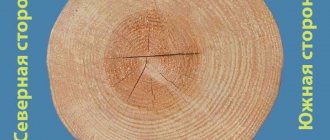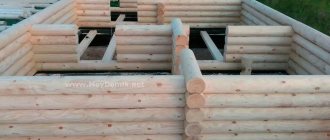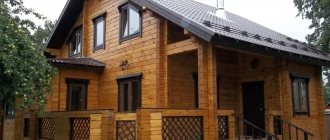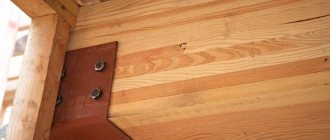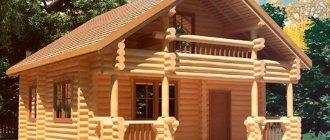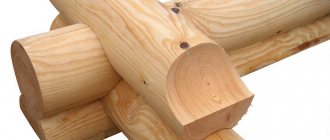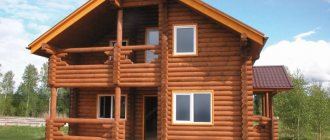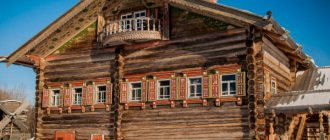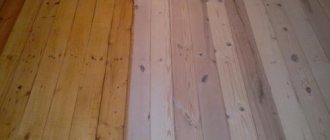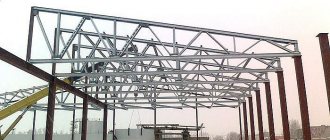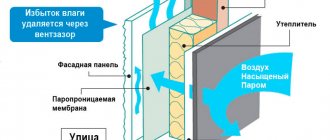What is a rounded log
To make this material for a log house, the trunk without branches is processed on several woodworking machines. First, it is cleared of bark. And then this workpiece is rounded to give it the required diameter. At the exit from the primary cutting shop, the resulting rounds are smooth, even and uniform in diameter.
The process of removing bark from rounded logs
After primary processing
Then this lumber is sawn into logs of the length required for the house design, and bowls are cut out at the ends. During the processing process, the machine removes most of the hard layer of wood from the trunk along with the bark. Only the core and core are taken into account. And because of their softness and porosity, they are prone to rotting.
Final sanding
To prevent rotting of a rounded log, it is impregnated with antiseptics, and at the same time with fire retardants and fungicides. As a result, a completely finished part for the walls of log houses and other buildings receives the necessary protection from fungi, fire and various woodworms.
The wood used for manufacturing is:
- Pine.
- Larch.
- Spruce.
- Cedar.
The main advantage of pine logs is their low cost. Cedar is more resistant to changes in humidity and temperature; it is recommended to use it for the construction of baths. Spruce, in comparison with pine, has lower strength and resistance to decay, but has a more presentable appearance. The advantages of larch are strength and durability. However, larch logs are also the most expensive and heaviest. A house made from it requires a more massive foundation.
Appearance of a pine log
Deciduous wood is not used for the production of rounded logs for various reasons. Oak is too expensive, birch is highly susceptible to rot, and aspen is soft and short-lived. These are more materials for interior decoration of a log house. It is better to build the walls of the cottage from coniferous wood.
Appearance of larch logs
Log houses are usually built from lumber of the same species. But practice has already confirmed that the combination of different types of wood is a completely justified and practical solution. The best option is to lay the lower crowns from expensive and moisture-resistant larch logs, and build the rest of the house from pine. It will not be too wasteful in terms of money, and will be more durable.
Types of machines for cylindering
There are two types of machines designed for processing workpieces.
The difference between them is the processing method
- Pass-through type machine.
The cutter remains stationary and the workpiece is pulled through it. These machines have great maneuverability, but the product after them has a significant drawback: it inherits the original curvature of the barrel. It is difficult to make a sealed log house from such a log. - Turning and milling machines.
the workpiece rotates in place, and the cutter moves along it. The productivity of the equipment is lower, but the quality of the logs is higher. These are the machines that are used at our factory. We have Sherwood machines, which provide high precision processing. All products have the shape of a regular cylinder with moon grooves of the correct shape. The maximum diameter of a rounded log is 400 mm.
How to choose logs for your home
The pros and cons of rounded logs used in the construction of low-rise cottages are different. Given the high demand for this material among builders, the former are clearly outnumbered by the latter. Its diameter varies in the range of 160–320 mm. There are options for arranging a gazebo, and for the construction of a small country house, and for the construction of a two-story residential building.
Types of logs by diameter
You can build a house from factory logs that have undergone rounding on your own without the involvement of a hired construction team. Such lumber is usually sold in the form of a finished frame, but disassembled into parts with numbered elements. This construction set only needs to be brought to the site and assembled in accordance with the project.
When choosing rounded logs for building a house, the main attention should be paid to:
- The absence of even a hint is not rot and wormholes;
- Compliance with its design specifications in terms of length, section and curvature;
- The presence of markings on the end;
- No chips or other mechanical damage;
- Degree of drying - whether it is naturally wet or dried in a chamber.
Follow the markings on the end
When choosing a log for your home, you should remember that chamber-dried logs are more expensive than their atmospheric-dried counterparts. The former have a humidity of about 12–18%, and the latter – in the region of 18–23%.
Log houses made from artificially dried wood are less susceptible to shrinkage after construction. If the walls of a building made of atmospheric-dry wood dry out and settle by 10–15 percent in the first year, then those made of artificially dry wood only by 1–2 percent.
Wet wood is more difficult to sand and treat differently than dry wood. Damp lumber does not absorb antibacterial and fire retardant compounds well. After harvesting the log house, a house made from logs that have not been dried is usually left for the winter to get rid of moisture naturally. And the building made from dried round timber is immediately ready for finishing and occupancy.
Pros and cons of rounded logs
Among the advantages of rounded logs are:
- Natural beauty of natural wood texture;
- Natural air exchange through wooden walls, helping to maintain a comfortable atmosphere in the cottage;
- High characteristics of heat and sound insulation of the house;
- Saving time and money on finishing due to the absence of the need for additional wall processing;
- Simplicity and high speed of assembly of a log house - such houses are assembled in just a couple of weeks;
- A variety of ready-made cottage projects with different interior designs;
- Absence of harmful emissions and complete environmental safety of building materials;
- Durability of the structure - a wooden building will last 60–80 years without any problems.
When choosing a rounded log for your home, you need to understand that without proper protection the tree will quickly rot. In most industries, this lumber is impregnated and coated with various compounds. But it also doesn’t hurt to treat the walls yourself.
In terms of architecture and layout, a house made of this material can be anything. This material allows you to implement the most bizarre designs, externally and internally. In terms of thermal insulation parameters and price, with equal wall thickness, wood is second only to SIP panels. However, in terms of environmental friendliness, wood will surpass a composite of OSB and polystyrene foam in all respects.
The disadvantages of rounded logs are as follows:
- Natural shrinkage, leading to twisting and bowing of the tree;
- Cracking of round timber after laying in a log house;
- Limitations in terms of finishing options in the house due to shrinkage of the latter;
- The need to treat lumber with protective agents;
- Fire hazard.
There are practically no disadvantages
A log house will take at least a year to settle down, during which time you won’t be able to do much with the finishing. Walls made of wood, in any case, will change their geometry during shrinkage. It is not for nothing that logs in such low-rise buildings are often left without any cladding. Then nothing will crack or go wrong.
Myth #1: A log without bark will deteriorate faster.
Logs specially processed on rounding machines are a relatively new material, but almost a quarter of a century of its use in Russian private housing construction speaks for itself. Just look at the first log houses made of rounded logs: they have successfully survived more than one winter and still not only look respectable, but also give warmth and comfort to their inhabitants.
What's the secret? The fact is that a log devoid of top layers is no worse than an untreated one. Quite the contrary. On the machine, part of the sapwood is removed from the tree trunk - the youngest upper layers covered with bast and bark. They are less durable than the harder internal ones and are more saturated with water, since their main function is to supply moisture to the crown. Loose sapwood is a favorite habitat for pests, dangerous fungi and relatively harmless blue stains. At the same time, sapwood is rich in resin, which increases the durability of coniferous wood.
After processing, 15 to 20 mm of sapwood remains on the rounded log - its strongest layer (the entire thickness of the sapwood is from 30 to 40 mm).
In this regard, it is completely incomprehensible why myth-makers are not concerned about the complete absence of a supposedly protective layer of sapwood in glued or profiled timber, and all far-fetched claims relate only to calibrated logs.
Photos of log houses
A wooden house made of rounded logs is an environmentally friendly, elegant and comfortable home. It is difficult to find a more practical and relatively inexpensive building material. Comparing the pros and cons of gas silicate blocks, brick and concrete with the advantages of this type of lumber, we can definitely say that wood is the best option in terms of all parameters. Its only significant drawback is its flammability. But there are fire-retardant impregnations for this.
Excellent material for a forest house
Interesting shape of a small log bathhouse
You can design the roof in an unusual way
Another option for a neat bath
A log house on a pile foundation looks like a hut on chicken legs
Another option for a forest house
Interesting project with a veranda made of logs
Simple and elegant
You can also build castles from rounded logs
Two-story log house with a veranda
A chic combination of rounded logs with natural stone
Unusual log house
One-story house with a small veranda
Log two-story house
Huge one-story house
Small log sauna
An interesting combination of a ground floor made of stone and a first floor made of logs
Two-story project with attic
Another interesting option for a house on an uneven plot
And finally, a real work of art made from rounded logs
